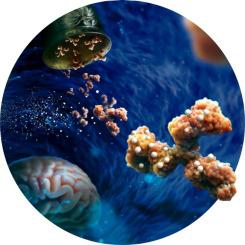Journal of Advanced Research ( IF 10.7 ) Pub Date : 2021-09-13 , DOI: 10.1016/j.jare.2021.09.003 Leonardo da Silva Neto 1 , Angélica Faleiros da Silva Maia 1 , Adriana Martins Godin 1 , Paulo Sérgio de Almeida Augusto 2 , Raissa Lima Gonçalves Pereira 2 , Sordaini Maria Caligiorne 2 , Rosemeire Brondi Alves 1 , Simone Odília Antunes Fernandes 3 , Valbert Nascimento Cardoso 3 , Gisele Assis Castro Goulart 4 , Felipe Terra Martins 5 , Maila de Castro Lourenço das Neves 2 , Frederico Duarte Garcia 2 , Ângelo de Fátima 1

|
Introduction
Cocaine use disorder is a significant public health issue without a current specific approved treatment. Among different approaches to this disorder, it is possible to highlight a promising immunologic strategy in which an immunogenic agent may reduce the reinforcing effects of the drug if they are able to yield sufficient specific antibodies capable to bind cocaine and/or its psychoactive metabolites before entering into the brain. Several carriers have been investigated in the anti-cocaine vaccine development; however, they generally present a very complex chemical structure, which potentially hampers the proper assessment of the coupling efficiency between the hapten units and the protein structure.
Objectives
The present study reports the design, synthesis and preclinical evaluation of two novel calix[n]arene-based anti-cocaine immunogens (herein named as V4N2 and V8N2) by the tethering of the hydrolysis-tolerant hapten GNE (15) on calix[4]arene and calix[8]arene moieties.
Methods
The preclinical assessment corresponded to the immunogenicity and dose–response evaluation of V4N2 and V8N2. The potential of the produced antibodies to reduce the passage of cocaine analogue through the blood–brain-barrier (BBB), modifying its biodistribution was also investigated.
Results
Both calix[n]arene-based immunogens elicited high titers of cocaine antibodies that modified the biodistribution of a cocaine radiolabeled analogue (99mTc-TRODAT-1) and decreased cocaine-induced behavior, according to an animal model.
Conclusion
The present results demonstrate the potential of V4N2 and V8N2 as immunogens for the treatment of cocaine use disorder.
中文翻译:

基于杯[n]芳烃的免疫原:一种新的非蛋白质抗可卡因疫苗策略
介绍
可卡因使用障碍是一个重大的公共卫生问题,目前尚无特定批准的治疗方法。在治疗这种疾病的不同方法中,有可能强调一种有前途的免疫学策略,其中免疫原性药物如果能够在进入药物之前产生足够的能够结合可卡因和/或其精神活性代谢物的特异性抗体,则可以降低药物的增强作用进入大脑。在抗可卡因疫苗的开发中已经对几种载体进行了调查;然而,它们通常呈现出非常复杂的化学结构,这可能会妨碍对半抗原单元和蛋白质结构之间偶联效率的正确评估。
目标
本研究报告了两种新型基于杯[ n ]芳烃的抗可卡因免疫原(本文命名为V4N2和V8N2)的设计、合成和临床前评估,通过将耐水解半抗原GNE ( 15 ) 束缚在杯[4 ]芳烃和杯[8]芳烃部分。
方法
临床前评估对应于V4N2和V8N2的免疫原性和剂量反应评估。还研究了产生的抗体减少可卡因类似物通过血脑屏障 (BBB) 的潜力,从而改变其生物分布。
结果
根据动物模型,两种基于杯[ n ]芳烃的免疫原均可引发高滴度可卡因抗体,从而改变可卡因放射性标记类似物 ( 99m Tc-TRODAT-1)的生物分布并降低可卡因诱导的行为。
结论
目前的结果证明了V4N2和V8N2作为免疫原治疗可卡因使用障碍的潜力。


























 京公网安备 11010802027423号
京公网安备 11010802027423号